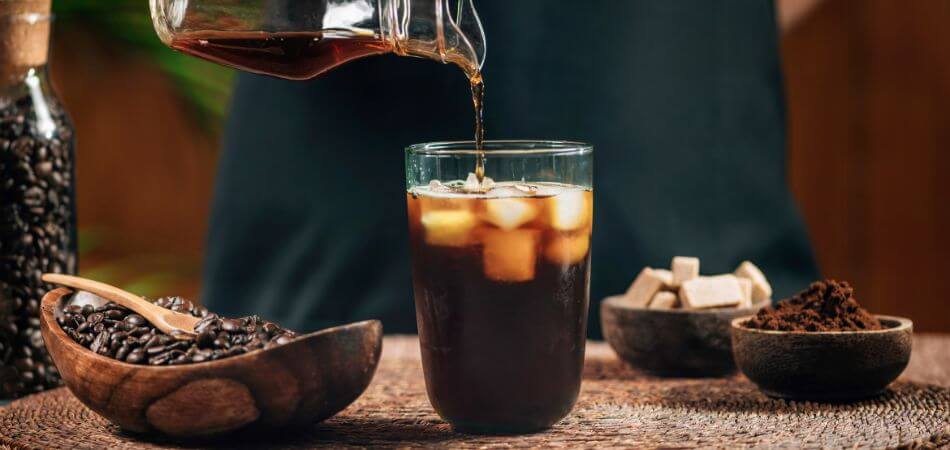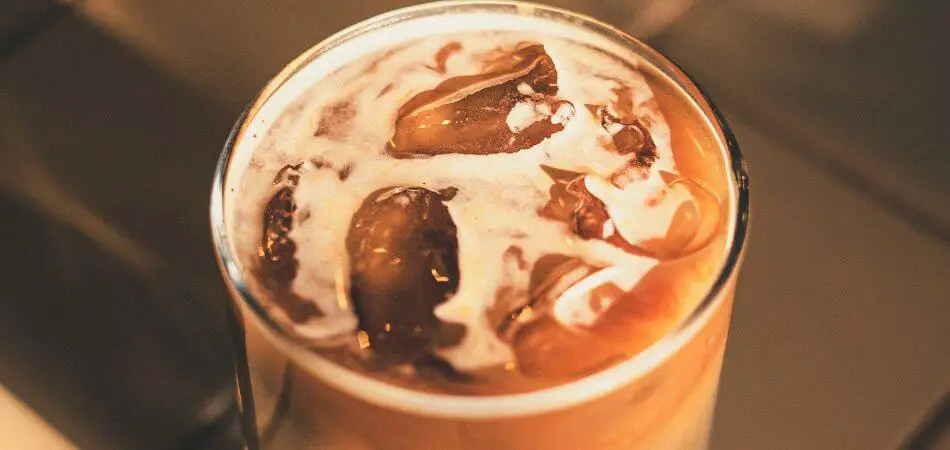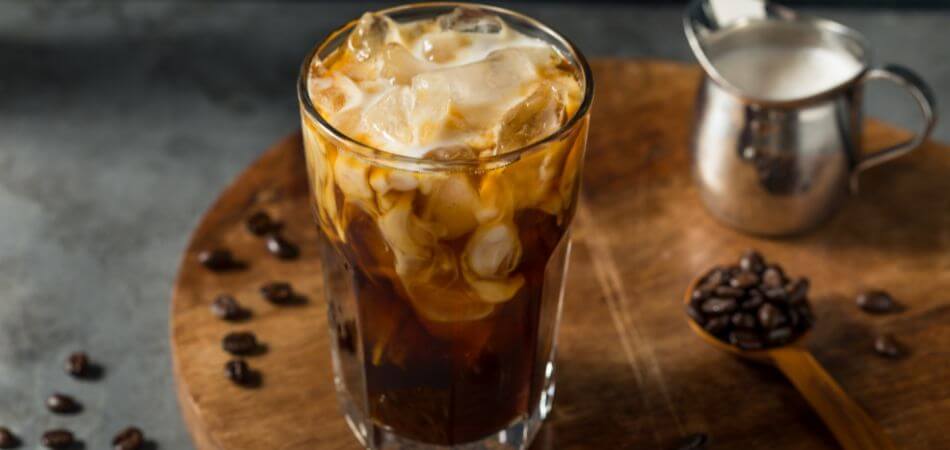How to Make Iced Coffee: A Step-by-Step Guide

Iced coffee has become a refreshing staple for coffee enthusiasts worldwide, offering a cool respite from the heat and a delightful caffeine boost. As temperatures rise, many coffee lovers find themselves craving a chilled version of their favorite brew. Learning how to make iced coffee at home opens up a world of customization and savings, allowing coffee aficionados to enjoy their perfect cup without breaking the bank.
This comprehensive guide will walk readers through the process of creating delicious iced coffee from scratch. It covers everything from selecting the right beans and equipment to mastering various brewing methods like cold brew and hot brew over ice. Additionally, the article explores ways to customize iced coffee with flavored syrups, milk alternatives, and creative recipes. By the end, readers will have the knowledge to whip up barista-quality iced coffee in their own kitchens, whether they prefer a simple iced Americano or a more elaborate Vietnamese-style iced coffee.
Understanding Iced Coffee Basics
Iced coffee has become a refreshing staple for coffee enthusiasts worldwide, offering a cool respite from the heat and a delightful caffeine boost. To truly appreciate this chilled beverage, it’s essential to understand the different methods of preparation and the unique flavor profiles they create.
Hot vs Cold Brew
When it comes to making iced coffee, there are two primary methods: hot brew and cold brew. Each method results in a distinct taste and texture, catering to different preferences.
Hot brew iced coffee is made by brewing coffee using hot water and then cooling it down with ice. This method is quick and easy, taking only 2-5 minutes to prepare. The hot water extracts flavors rapidly, resulting in a bright, acidic, and slightly bitter taste profile. The coffee is then poured over ice, which can dilute the flavor if not prepared correctly.
On the other hand, cold brew is made by steeping coffee grounds in cold water for an extended period, typically 12-24 hours. This slow extraction process yields a smooth, less acidic, and naturally sweet flavor. Cold brew is often prepared as a concentrate, which can be diluted with water or milk to taste.
Flavor Profiles
The flavor profiles of hot brew and cold brew iced coffees differ significantly due to their preparation methods.
Hot brew iced coffee retains the familiar taste of traditional coffee, with a crisp acidity and balanced bitterness. It offers a full-bodied flavor with bright, floral notes and a refreshing quality. However, if not prepared properly, it can become watery as the ice melts.
Cold brew, in contrast, has a smoother, less acidic taste with subtle nutty undertones. It’s known for its rich, full-bodied flavor and low bitterness. The cold brewing process results in up to 66% less acidity compared to hot brewed coffee, making it easier on sensitive stomachs. Cold brew also has a reputation for incredibly rich aromas, as the aromatic compounds remain in liquid form rather than evaporating as they would in hot coffee.
Both methods have their unique advantages. Hot brew iced coffee is perfect for those who enjoy a traditional coffee taste with a refreshing twist. It’s ideal for warm afternoons, sunny walks in the park, or bright-skied road trips. Cold brew, on the other hand, is versatile and can be used as a base for various creative coffee drinks, from iced lattes to coffee cocktails.
Understanding these basics allows coffee lovers to choose the method that best suits their taste preferences and lifestyle. Whether you prefer the bright acidity of hot brew or the smooth sweetness of cold brew, mastering these techniques will help you create the perfect iced coffee at home.

Essential Equipment
To make delicious iced coffee at home, having the right equipment is crucial. While it’s possible to create a refreshing cold brew with basic kitchen tools, investing in specialized gear can elevate the experience and make the process more efficient.
Coffee Maker
For those who prefer the hot brew method, a reliable coffee maker is essential. A standard drip coffee maker can produce strong coffee that can be cooled and poured over ice. However, for a more concentrated brew, consider using an AeroPress or French press. These devices allow for greater control over the brewing process and can create a robust coffee that won’t become diluted when mixed with ice.
For iced coffee enthusiasts, specialized iced coffee makers are available. These machines are designed to brew coffee directly over ice, ensuring a strong and flavorful result. Some popular options include the Mr. Coffee Iced Coffee Maker and the Ninja Hot and Cold Brewed System. These machines often come with reusable tumblers or carafes, which can help reduce waste and keep your iced coffee cold for longer periods.
Grinder
A high-quality burr grinder is a game-changer for making iced coffee. Unlike blade grinders, which can produce inconsistent results, burr grinders create uniform coffee grounds. This consistency is crucial for achieving balanced flavors in your iced coffee.
When choosing a grinder, consider models with multiple grind settings. This flexibility allows you to adjust the coarseness of your grounds based on your preferred brewing method. For example, cold brew typically requires a coarser grind than hot brewed iced coffee.
Some recommended burr grinders include the Baratza Encore, which offers 40 grind settings, and the OXO Brew Conical Burr Grinder, which features an integrated scale for precise measurements. These grinders provide excellent value for home brewers looking to improve their iced coffee game.
Storage Containers
Proper storage is essential for maintaining the freshness of your coffee beans and preserving the flavor of your brewed iced coffee. For storing beans, look for airtight containers that protect them from light, heat, and moisture. Mason jars with tight-fitting lids are a popular and cost-effective option.
When it comes to storing brewed iced coffee, large glass pitchers or carafes are ideal. These containers allow you to brew and store larger batches, perfect for those hot summer days when you want a constant supply of cold coffee. Look for pitchers with pour spouts and tight-fitting lids to make serving easy and keep your coffee fresh.
For those who enjoy experimenting with different flavors, consider investing in a set of glass bottles or jars for storing homemade syrups or flavored creamers. These add-ins can transform a simple iced coffee into a gourmet treat.
By investing in these essential pieces of equipment, you’ll be well-prepared to create delicious iced coffee at home. Whether you prefer a classic iced Americano or a creamy Vietnamese-style iced coffee, having the right tools will help you achieve consistent and satisfying results every time.
Selecting Quality Coffee Beans
Choosing the right coffee beans is crucial for making delicious iced coffee. The quality of the beans significantly impacts the flavor, aroma, and overall experience of your cold brew or iced coffee. When selecting coffee beans for iced coffee, it’s essential to consider factors such as origin and roast level.
Origin
The geographical location where coffee beans are grown has a profound effect on their taste profile. Coffee beans from different regions around the world offer unique characteristics and flavors. For iced coffee, it’s recommended to choose beans that complement the cold brewing process and maintain their distinct flavors when chilled.
Single-origin coffees, sourced from specific regions, can bring worldly flavors to your cup. These beans often exhibit unique characteristics that reflect their growing environment. For example, beans from Central America might offer bright, citrusy notes, while those from Indonesia tend to have a fuller body with earthy undertones.
When selecting beans for iced coffee, consider options from regions known for producing low-acid coffees, such as Sumatra or Brazil. These beans often create smooth, full-flavored iced coffees that don’t become overly bitter when cooled. Alternatively, if you enjoy fruity and floral notes in your iced coffee, you might opt for beans from African countries like Ethiopia or Kenya.
It’s worth noting that some coffee roasters offer blends specifically designed for cold brew or iced coffee. These blends often combine beans from different origins to create a balanced flavor profile that works well when served cold.
Roast Level
The roast level of coffee beans plays a significant role in determining the flavor of your iced coffee. While personal preference ultimately dictates the best roast for you, certain roast levels tend to work better for cold brewing methods.
Dark roast coffee beans are often recommended for making iced coffee and cold brew. The deep, rich flavors of dark roasts hold up well when diluted with ice and milk. Dark roasts also tend to have lower acidity, which can result in a smoother, less bitter iced coffee. The bold, chocolatey notes often associated with dark roasts can create a decadent iced coffee experience.
Medium roasts offer a balanced option for iced coffee. They retain more of the bean’s original flavors while still providing a full-bodied taste. Medium roasts often exhibit caramel or nutty notes that can be quite enjoyable in a cold coffee drink.
Light roasts, while less common for iced coffee, can produce interesting results. They often highlight the unique characteristics of the bean, including fruity or floral notes. However, light roasts can be more challenging to work with when making iced coffee, as their delicate flavors may become muted when chilled.
When choosing a roast level for your iced coffee, consider your personal taste preferences and the brewing method you plan to use. If you’re using a cold brew method, darker roasts often work well. For hot-brewed iced coffee, you might experiment with medium or light roasts to highlight different flavor notes.
Remember, freshness is key when selecting coffee beans for iced coffee. Look for beans with a recent roast date, as freshly roasted beans will provide the best flavor. By carefully considering the origin and roast level of your coffee beans, you can create a refreshing and flavorful iced coffee that suits your taste preferences.

The Classic Hot Brew Method
The classic hot brew method is a popular technique for making iced coffee that delivers a refreshing and flavorful drink. This approach involves brewing coffee using hot water and then cooling it rapidly to create a chilled beverage. The hot brew method offers several advantages, including a quicker preparation time compared to cold brew and the ability to extract a wider range of flavors from the coffee beans.
Brewing Process
To make iced coffee using the hot brew method, start by selecting your preferred brewing device. Many coffee enthusiasts use a drip coffee maker, French press, or Aeropress for this purpose. The key is to brew a strong concentrate that can withstand dilution from ice without losing its rich flavor.
When using a drip coffee maker, it’s essential to adjust the coffee-to-water ratio. A good rule of thumb is to use about 1.5 times the amount of coffee grounds you would typically use for hot coffee. This ensures that the resulting brew is strong enough to maintain its flavor when poured over ice.
For those using an Aeropress, a popular recipe involves using 17 grams of coffee (ground slightly finer than table salt) and 170 grams of hot water, just off the boil (around 205°F). Stir the mixture, place the plunger on top, and let it sit for two minutes before plunging slowly and steadily.
If you prefer a pour-over method, such as using a Chemex, consider trying the Japanese-style iced coffee technique. This involves substituting about 40% of your water with ice. For a 12-ounce serving, use 25 grams of medium-finely ground coffee, 250 grams of hot water (between 205°F and boiling), and 150 grams of ice in the decanter you’re brewing into.
Regardless of the brewing method, it’s crucial to use freshly roasted, high-quality coffee beans for the best flavor. Medium to dark roasts often work well for iced coffee, as they can stand up to the dilution from ice.
Cooling Techniques
Once you’ve brewed your coffee concentrate, the next step is to cool it quickly to prevent oxidation and preserve the coffee’s flavors. There are several effective cooling techniques to choose from:
- Flash-chilling: This method involves brewing coffee directly onto ice. The hot coffee immediately melts the ice, cooling the brew and diluting it to the perfect strength. This technique, also known as Japanese-style iced coffee, helps preserve the coffee’s aromatic compounds and results in a bright, clean flavor.
- Slow cooling: Some baristas recommend letting the coffee cool naturally to room temperature before refrigerating. This method can result in a less bitter taste, as cooling already bitter coffee quickly can lead to oxidation, which can overpower the subtle, sweeter notes.
- Ice bath: For a quicker cooling method, place your brewed coffee in a metal container and submerge it in an ice bath. This rapidly cools the coffee without diluting it. For even faster cooling, add salt to the ice bath, which can lower the temperature further through freezing point depression.
- Coffee ice cubes: To avoid diluting your iced coffee as the ice melts, consider making coffee ice cubes in advance. Simply freeze leftover coffee in an ice cube tray and use these instead of regular ice cubes when serving.
When serving your iced coffee, use a glass to appreciate the visual appeal of the drink. You can customize your iced coffee by adding milk, flavored syrups, or sweeteners to enhance the natural caramel, chocolate, and vanilla notes of the coffee beans.
By mastering the classic hot brew method and experimenting with different cooling techniques, you can create delicious iced coffee at home that rivals your favorite coffee shop’s offerings. Remember to adjust the strength and flavors to your personal preferences, and don’t be afraid to get creative with your iced coffee recipes.

Mastering Cold Brew
Cold brew coffee has gained popularity for its smooth, less acidic taste and refreshing qualities. This method involves steeping coffee grounds in cold water for an extended period, resulting in a concentrated brew that can be enjoyed over ice or diluted to taste. Mastering the art of cold brew coffee requires attention to detail and patience, but the results are well worth the effort.
Ratio of Coffee to Water
One of the key factors in creating a delicious cold brew is finding the right balance between coffee and water. The ratio you choose will depend on whether you’re making a concentrate or a ready-to-drink cold brew.
For a cold brew concentrate, a ratio of 1:5 (coffee to water) is often recommended. This means using 200 grams of coffee per liter of water. This concentrated version allows for versatility in serving, as it can be diluted with water, milk, or other liquids to suit individual preferences.
If you prefer a ready-to-drink cold brew, a ratio of 1:15 (coffee to water) works well. This translates to about 67 grams of coffee per liter of water. This ratio produces a brew similar to filter coffee in taste and texture, highlighting the nuances of more delicate coffee beans.
It’s important to note that these ratios are flexible and can be adjusted to suit your taste. Some popular cold brew brands use different ratios. For example, La Colombe’s Cold Brew Concentrate recommends a ratio of 1 part concentrate to 3 parts water, which makes 16 8-ounce cups of cold brew from a 32-ounce bottle of concentrate.
Steeping Time
The steeping time for cold brew coffee is another crucial factor that affects the final taste. Unlike hot brewing methods, cold brew requires a much longer extraction process to draw out the flavors from the coffee grounds.
Most cold brew recipes recommend a steeping time between 12 to 24 hours. However, the sweet spot for many coffees falls within the 16 to 20-hour range. It’s best to start with a 16-hour batch, taste it, and adjust the time for future brews based on your preference.
Here are some guidelines for steeping time:
- Minimum steeping time: 12 hours. This is the minimum recommended time regardless of batch size, equipment, or temperature. Anything less may result in under-extraction.
- Ideal steeping time: 16 to 20 hours. This range often produces the best balance of flavors for most coffees.
- Maximum steeping time: 24 hours. Steeping beyond this point can lead to over-extraction, resulting in bitter and unpleasant flavors.
It’s worth noting that some commercial cold brews, like Starbucks, steep their coffee for 20 hours. However, home brewers should be cautious about extending the steeping time beyond 24 hours, as it can lead to woody or dusty flavor profiles.
When making cold brew, it’s essential to use coarsely ground coffee, about the texture of coarse sugar or thick kosher salt. This grind size helps prevent over-extraction and ensures a smooth, clean-tasting brew.
Remember, cold brew is typically made as a concentrate and should be diluted before drinking. A common dilution ratio is 1:1 (one part concentrate to one part water or milk), but this can be adjusted to suit your taste preferences.
By mastering the ratio of coffee to water and the steeping time, you’ll be well on your way to creating delicious cold brew coffee at home. Experiment with different ratios and steeping times to find the perfect combination that suits your palate.
Customizing Your Iced Coffee
One of the joys of making iced coffee at home is the ability to customize it to suit your taste preferences. Whether you’re looking for a healthier alternative to traditional dairy or seeking to add a touch of sweetness without the guilt, there are numerous ways to personalize your iced coffee experience.
Milk Alternatives
For those who prefer non-dairy options or are looking to experiment with different flavors, there’s a wide array of milk alternatives available. Each option brings its unique taste and texture to your iced coffee:
- Oat Milk: Known for its creamy texture and subtle sweetness, oat milk has become a popular choice for iced coffee enthusiasts. It complements the coffee’s flavor without overpowering it and creates a smooth, rich drink.
- Almond Milk: This nutty alternative adds a light, refreshing taste to iced coffee. It’s particularly enjoyable in iced lattes and works well with flavored syrups.
- Coconut Milk: For a tropical twist, coconut milk can add a hint of sweetness and a creamy texture to your iced coffee. It pairs exceptionally well with cold brew and can transform your drink into a vacation-worthy treat.
- Soy Milk: A classic non-dairy option, soy milk offers a neutral flavor that allows the coffee to shine through. It’s also a good source of protein, making it a nutritious choice.
- Cashew Milk: This creamy alternative has a mild, slightly sweet flavor that complements iced coffee without overwhelming it. It’s an excellent choice for those who enjoy a smoother texture in their drink.
When using milk alternatives, it’s essential to consider their consistency and how well they blend with coffee. Some plant-based milks may separate when added to cold coffee, so stirring well or using a frother can help achieve a more uniform mixture.
Natural Sweeteners
For those looking to add sweetness to their iced coffee without relying on refined sugar, there are several natural alternatives that can enhance the flavor profile of your drink:
- Honey: A versatile sweetener, honey adds a complex sweetness to iced coffee. Different varieties of honey can bring unique flavor notes, from floral to earthy. To incorporate honey into cold coffee, mix it with a small amount of hot water first to create a syrup that blends easily.
- Maple Syrup: Real maple syrup can add a rich, caramel-like sweetness to iced coffee. It dissolves easily in cold liquids and pairs particularly well with darker roasts.
- Agave Nectar: This plant-based sweetener is sweeter than sugar, so a little goes a long way. It has a neutral flavor that won’t overpower the taste of your coffee and blends smoothly into cold drinks.
- Date Sugar: Made from ground dates, this natural sweetener adds a subtle caramel flavor to iced coffee. It also provides some fiber and nutrients, making it a healthier alternative to refined sugar.
- Stevia: For those looking for a zero-calorie option, stevia is a natural sweetener derived from plant leaves. It’s much sweeter than sugar, so use it sparingly to avoid an overpowering taste.
When experimenting with natural sweeteners, start with small amounts and adjust to taste. Each sweetener has its unique flavor profile, so you may need to try a few before finding your perfect match.
By exploring different milk alternatives and natural sweeteners, you can create a customized iced coffee that not only satisfies your taste buds but also aligns with your dietary preferences and health goals. Don’t be afraid to mix and match – the perfect iced coffee recipe is just a few experiments away!

Creative Iced Coffee Recipes
For those looking to elevate their iced coffee experience, experimenting with creative recipes can be a delightful journey. Two popular variations that offer unique flavors and cultural experiences are Vietnamese Iced Coffee and Mocha Frappé.
Vietnamese Iced Coffee
Vietnamese Iced Coffee, known as Cà Phê Sữa Đá, is a refreshing and indulgent beverage that combines strong coffee with sweetened condensed milk. This drink is perfect for those who enjoy a bold coffee flavor with a sweet, creamy twist.
To make Vietnamese Iced Coffee at home:
- Brew a strong cup of coffee using a dark roast or Vietnamese coffee blend.
- In a tall glass, add 1-2 tablespoons of sweetened condensed milk.
- Pour the hot coffee over the sweetened condensed milk.
- Stir well to combine the coffee and milk.
- Fill the glass with ice cubes and enjoy.
For an authentic experience, use a Vietnamese coffee filter called a “phin” to brew the coffee directly over the sweetened condensed milk. This method allows the coffee to slowly drip, creating a rich and intense flavor.
To add a modern twist, try making coffee ice cubes by freezing leftover coffee. This prevents dilution as the ice melts, maintaining the strong coffee flavor throughout.
Mocha Frappé
A Mocha Frappé is a delicious blend of coffee, chocolate, and ice, creating a smooth and creamy frozen treat. This recipe is perfect for those hot summer days when you need a refreshing coffee fix.
To make a Mocha Frappé at home:
- Brew a strong cup of coffee and let it cool to room temperature.
- In a blender, combine:
- 1 cup of cooled coffee
- 1/4 cup of milk or half-and-half
- 2 tablespoons of chocolate syrup
- 2 tablespoons of sugar (adjust to taste)
- 2 cups of ice
- Blend until smooth and frothy.
- Pour into a tall glass and top with whipped cream and a drizzle of chocolate syrup.
For a healthier version, substitute regular milk with almond or oat milk, and use a sugar-free chocolate syrup. You can also add a scoop of protein powder to turn this into a more substantial snack.
To enhance the coffee flavor, try using cold brew coffee instead of regular brewed coffee. Cold brew offers a smoother, less acidic taste that works well in frozen drinks.
These creative iced coffee recipes allow coffee enthusiasts to explore new flavors and textures while enjoying their favorite beverage. Whether you prefer the bold sweetness of Vietnamese Iced Coffee or the indulgent creaminess of a Mocha Frappé, these recipes provide a delightful alternative to traditional iced coffee. Experiment with different coffee beans, milk alternatives, and sweeteners to find your perfect blend and make the best iced coffee tailored to your taste preferences.
Conclusion
Mastering the art of making iced coffee at home has a significant impact on both your taste buds and your wallet. By exploring different brewing methods, from the classic hot brew to the smooth cold brew, coffee enthusiasts can create refreshing drinks tailored to their preferences. The ability to customize your iced coffee with various milk alternatives and natural sweeteners opens up a world of flavors to explore, allowing you to craft the perfect cup for any occasion.
Whether you’re whipping up a Vietnamese Iced Coffee or blending a creamy Mocha Frappé, the possibilities for creating delicious iced coffee drinks are endless. With the right techniques and a bit of creativity, you can enjoy barista-quality iced coffee right in your own kitchen. So grab your favorite beans, brew up a batch, and get ready to cool down with a refreshing glass of homemade iced coffee.
FAQs
What is the proper method for preparing iced coffee?
To make iced coffee, fill your cup, mug, or tumbler at least three-quarters full with ice. Next, pour your brewed coffee over the ice and stir well. Iced coffee is highly customizable, allowing you to enjoy it black or with your preferred milk or cream.
What is the ideal coffee-to-water ratio for making iced coffee?
For iced coffee, use a coffee to ice water ratio of 1:12. For instance, you might use 50 grams of coarsely ground coffee, 300 grams of ice, and 300 grams of water. Bear in mind that the mixture will expand, so a larger container is necessary. It is recommended to steep the mixture for about 15 hours.
How can you enhance your iced coffee?
To elevate your iced coffee, consider adding whole milk or alternatives like almond or coconut milk for a delicious twist. You can also experiment with various add-ins such as a few teaspoons of cream or even a generous scoop of ice cream.
How can you make barista-level iced coffee at home?
To prepare iced coffee similar to a barista, use 12 grams (approximately 3/4 tablespoon) of coffee for every 180 milliliters (6 ounces) of filtered, simmering water. Pour the hot water over the coffee, wait for 30 seconds, then stir. Allow it to brew for at least 4 to 6 minutes. Slowly press the plunger down if using a French press, then serve the coffee over a glass filled with medium-sized ice cubes.




